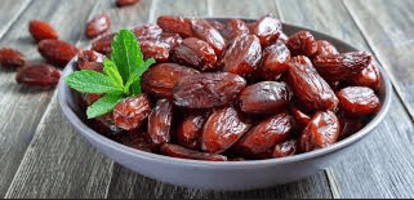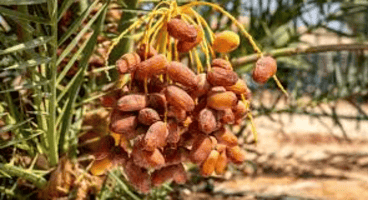Imagine transforming your favorite desserts and treats with a natural sweetener that not only satisfies your sweet tooth but also provides valuable nutrients. Dates, nature’s candy, offer exactly that opportunity. As we become increasingly conscious about refined sugar consumption, many home cooks and professional chefs are turning to dates in their culinary creations.
These fruit gems, rich in fiber, potassium, and antioxidants, can revolutionize your approach to sweetening foods while adding complex caramel-like flavors that sugar simply cannot match.
From creating basic date paste to incorporating this wholesome ingredient into everything from morning smoothies to decadent desserts, you’ll discover why dates have become the sweetener of choice for health-conscious individuals who refuse to compromise on taste.
This guide will equip you with all the knowledge you need to begin your date-sweetened culinary journey.

The Natural Sweetness of Dates
Dates have been cherished for millennia across Middle Eastern and North African cuisines, not just for their natural sweetness but for their impressive nutritional profile. Unlike refined sugar that offers empty calories, dates provide a rich matrix of nutrients alongside their sweetening power:
Nutritional Benefits of Dates
- Rich in dietary fiber (7-12g per 100g) that helps regulate digestion
- Excellent source of potassium, magnesium, and B vitamins
- It has antioxidants which aid in the fight against oxidative stress.
- Provides iron, calcium, and phosphorus for overall health
- Offers a lower glycemic load than refined sugar when consumed in whole form
The sweet profile of dates comes primarily from their natural fruit sugars—fructose, glucose, and sucrose. What makes dates particularly special as a sweetener is their complexity of flavor. Beyond just sweetness, dates contribute caramel, butterscotch, and sometimes even chocolate notes to recipes, adding depth that one-dimensional sweeteners like white sugar
Popular Date Varieties for Sweetening
- Medjool dates – Large, soft and exceptionally sweet with a caramel-like taste
- Deglet Noor dates – Firmer texture with a more mild sweetness and nutty undertones
- Barhi dates – Exceptionally soft with notes of cinnamon and butterscotch
- Zahidi dates – Medium sweetness with a slightly fibrous texture
- Halawi dates – Very sweet with a caramel flavor and soft texture
Basic Date Sweetener Preparations
Before incorporating dates into recipes, preparing them in a form that distributes their sweetness evenly is essential. Here are the foundational date sweetener preparations that will serve as building blocks for countless recipes:

Date Paste: The Foundation
Date paste serves as the most versatile form for using dates as a sweetener. It blends seamlessly into batters, doughs, and sauces.
Equipment needed:
- Food processor or high-powered blender
- Measuring cups
- Spatula
- Airtight container for storage
Ingredients:
- 2 cups pitted dates (preferably Medjool)
- ½ to ¾ cup warm water
Preparation steps:
- After placing the pitted dates in a basin, pour warm water over them.
- Let soak for 30-60 minutes until softened.
- Drain dates, reserving the soaking liquid.
- Transfer softened dates to a food processor or blender.
- Process dates while gradually adding reserved soaking liquid until a smooth, spreadable consistency forms.
- Keep for up to two weeks in the refrigerator for in an airtight container.
Important tips for success
- Adjust water quantity based on the initial moisture level of your dates
- For a smoother paste, soak dates longer if they’re particularly dry
- Add a splash of lemon juice to extend refrigerator life
- For recipes requiring a neutral flavor, use lighter-colored date varieties
Date Syrup: Liquid Gold
Date syrup (also called date honey or silan) provides a pourable option similar to maple syrup or honey.
Equipment needed:
- Medium saucepan
- Fine mesh strainer
- Cheesecloth
- Bottle for storage
- Measuring cups
Ingredients:
- 2 cups pitted dates
- 4 cups water
- Pinch of salt (optional)
Preparation steps:
- Mix water and dates in a medium saucepan.
- Let it boil, then lower heat and let it simmer for 45-60 minutes until dates are very soft and water has reduced.
- Allow mixture to cool slightly, then strain through a fine-mesh strainer lined with cheesecloth, pressing gently to extract liquid.
- Return strained liquid to saucepan and simmer over low heat until reduced to desired consistency.
- Cool completely before transferring to a bottle for storage.
Important tips for success
- Simmer on lowest possible heat to prevent burning
- The longer the reduction, the thicker and more concentrated the syrup becomes
- Add spices like cinnamon or cardamom during simmering for flavored variations
- This can keep for up to 4 weeks in the refrigerator
Date Sugar: Dry Alternative
For recipes requiring a dry sweetener, date sugar serves as an excellent substitute for brown sugar.
Equipment needed:
- Baking sheet
- Food processor or coffee grinder
- Airtight container
Ingredients:
- 2 cups pitted dates
Preparation steps:
- Preheat oven to 250°F (120°C).
- Spread pitted dates on a baking sheet
- Bake for 2-3 hours until completely dried but not burnt.
- Allow to cool completely.
- Process dried dates in a food processor or coffee grinder until a granulated sugar-like consistency is achieved.
- Keep in cool, dry place in an airtight container.
Important tips for success
- Ensure dates are completely dried before grinding
- For finer sugar, sift after processing and re-grind larger pieces
- Store with a desiccant packet to prevent clumping in humid environments
Baking with Dates as Sweetener
When it comes using dates as sweetener in baking, understanding proper substitution ratios and technique modifications is key to success. Here’s how to incorporate dates into your favorite baked goods:
General Substitution Guidelines
- 1 cup white sugar = 1 cup date paste (reduce liquid in recipe by approximately ¼ cup)
- 1 cup brown sugar = 1 cup date paste with no liquid adjustment needed
- 1 cup honey or maple syrup = 1¼ cups date syrup
- 1 cup granulated sugar = 1 cup date sugar (though it won’t caramelize or melt like regular sugar)
- Vegetables, tofu, or tempeh during the last few minutes of cooking
Recipe Adjustments When Using Date Sweeteners
- Reduce baking temperature by 25°F (15°C) as date sugars can brown more quickly
- Increase leavening agents slightly (about ¼ teaspoon more baking soda per cup of date paste)
- Expect a denser, moister final product
- Allow baked goods to cool completely for best texture
- Extend baking time by 5-10 minutes for recipes with high date paste content
Date-Sweetened Banana Bread Recipe
Equipment needed:
- Loaf pan
- Mixing bowls
- Whisk
- Spatula
- Measuring cups and spoons
Ingredients
- 3 medium ripe bananas, mashed
- ⅔ cup date paste
- ¼ cup coconut oil, melted
- 2 large eggs
- 1 teaspoon vanilla extract
- 1¾ cups whole wheat flour
- 1 teaspoon baking soda
- ½ teaspoon salt
- ½ teaspoon cinnamon
- ½ cup chopped walnuts (optional)
Preparation steps:
- Preheat oven to 325°F (165°C) and line a loaf pan with parchment paper.
- In a large bowl, combine mashed bananas, date paste, coconut oil, eggs, and vanilla extract.
- Mix the flour, baking soda, salt, and cinnamon in a different bowl.
- Simply add the dry and liquid ingredients together gently.
- Add in walnuts if using.
- Pour batter into prepared loaf pan and bake for 55-65 minutes until a toothpick inserted in the center comes out clean.
- After 10 minutes of cooling in the pan, move to a cooling rack.
Important tips for success
- To get the most sweetness, use really ripe bananas with brown spots.
- Don’t overmix the batter to ensure a tender crumb
- Tent with foil during the last 15 minutes if bread is browning too quickly
- Store wrapped in parchment paper then aluminum foil for best freshness
Beverages and Smoothies with Date Sweetener
Dates make an excellent natural sweetener for drinks, imparting richness and body along with sweetness. Here’s how to use dates as sweetener in your favorite beverages:
Date-Sweetened Almond Milk
Equipment needed:
- High-powered blender
- Nut milk bag or fine-mesh strainer
- Storage bottle
- Measuring cups
Ingredients:
- 1 cup raw almonds, soaked overnight
- 4 cups filtered water
- 3-4 pitted dates
- ¼ teaspoon vanilla extract
- Pinch of salt
Preparation steps:
- Drain and rinse soaked almonds.
- Place almonds, filtered water, pitted dates, vanilla extract, and salt in a high-powered blender.
- Use high speed when blending for 1-2 minutes until smooth.
- Strain mixture through a nut milk bag or fine-mesh strainer lined with cheesecloth.
- Transfer to a bottle and refrigerate for up to 5 days.
Important tips for success
- Adjust date quantity based on desired sweetness
- Soak dates with almonds if they’re particularly dry
- Save leftover almond pulp for baking or adding to smoothies
- Shake well before using as separation will occur
Date-Sweetened Morning Smoothie
Equipment needed:
- Blender
- Measuring cups and spoons
Ingredients:
- 1 frozen banana
- 3 pitted dates
- 1 cup unsweetened plant milk
- 1 tablespoon almond butter
- 1 tablespoon chia seeds
- ½ teaspoon cinnamon
- Ice cubes (optional)
Preparation steps:
- Combine all ingredients in a blender.
- Blend on high until smooth and creamy.
- If additional liquid is required to reach the appropriate consistency, add more.
- Serve immediately
Important tips for success
- Soak dates for 10 minutes in warm water before blending if not using a high-powered blender
- Add a handful of spinach for added nutrition without affecting flavor
- Use frozen banana chunks for a thicker, creamier texture
No-Bake Treats with Date Sweetener
One of the most accessible ways to begin using dates as a sweetener is through no-bake treats where their binding properties and natural sweetness shine.
Date-Sweetened Energy Balls
Equipment needed:
- Food processor
- Measuring cups and spoons
- Small bowl
- Baking sheet or plate
Ingredients:
- 1 cup pitted dates
- ½ cup rolled oats
- ½ cup almond butter
- ¼ cup unsweetened cocoa powder
- 2 tablespoons chia seeds
- 1 teaspoon vanilla extract
- Pinch of salt
- Unsweetened shredded coconut for rolling (optional)
Preparation steps:
- Process dates in a food processor until they form a paste.
- Add in the remaining ingredients until thoroughly blended.
- Roll the mixture into balls after scooping it by using tablespoon.
- Roll in shredded coconut if desired.
- This can be kept in the refrigerator for at least 30 minutes before serving.
Important tips for success
• If the mixture is too dry, gradually add one teaspoon of water after another.
• Add extra oats if the mixture is semi-solid.
• This can keep for up to two weeks in an airtight container in the refrigerator
• It can be frozen for up to three months in case of longer storage
Savory Applications for Date Sweetener
While we often think of sweeteners for desserts, dates can enhance savory dishes by balancing flavors and adding depth. Here’s how to use dates as sweetener in savory cooking:
Date-Sweetened BBQ Sauce
Equipment needed:
- Saucepan
- Blender or immersion blender
- Measuring cups and spoons
- Storage jar
Ingredients:
- ½ cup date paste
- 1 cup tomato paste
- ¼ cup apple cider vinegar
- 2 tablespoons soy sauce or tamari
- 1 tablespoon Dijon mustard
- 2 teaspoons smoked paprika
- 1 teaspoon garlic powder
- 1 teaspoon onion powder
- ½ teaspoon black pepper
- 1 cup water
Preparation steps:
- Place all of the ingredients in a pot and apply medium heat.
- Whisk to mix thoroughly and then bring to a simmer.
- Reduce heat and simmer for 15-20 minutes until thickened, stirring occasionally.
- Use an immersion blender to mix the sauce for a smoother consistency.
- Allow to cool before transferring to a storage jar.
Important tips for success
- Add chipotle powder or cayenne for a spicy variation
- To make the sauce thinner, add extra water.
- This can be kept in the refrigerator for up to two weeks
- Brush on grilled vegetables, tofu, or tempeh during the last few minutes of cooking
Common Issues and Solutions
- Date paste is too thick: Add water one teaspoon at a time until desired consistency is reached
- Date sweetened baked goods are too dense: Increase leavening agents slightly or incorporate whipped egg whites for lightness
- Date pieces visible in final product: Ensure dates are completely broken down in food processor, or strain date paste for smoother consistency
- Date-sweetened treats aren’t sweet enough: Use Medjool dates for maximum sweetness or combine with small amounts of other natural sweeteners like maple syrup
- Date sugar is clumping: Store with a desiccant packet and break up clumps with a fork before using
Storage and Shelf Life
Proper storage is crucial for maintaining the quality and extending the shelf life of your date sweeteners:
Storage Guidelines
- Date paste: Refrigerate in airtight container for up to 2 weeks, freeze for up to 3 months
- Date syrup: Refrigerate in glass bottle for up to 1 month
- Date sugar: Store in airtight container in cool, dry place for up to 6 months
- Date-sweetened baked goods: Room temperature for 2-3 days, refrigerate for up to 1 week, freeze for up to 3 months
- Date energy balls/bars: Refrigerate for up to 2 weeks, freeze for up to 3 months
Temperature Control Tips
- Always cool date preparations completely before refrigerating
- Avoid repeated temperature fluctuations which can promote spoilage
- Bring refrigerated date paste to room temperature before using in cold dishes
- Store date sugar away from humidity sources to prevent clumping
FAQs
Are dates healthier than sugar?
Dates are generally considered healthier than refined sugar because they contain fiber, vitamins, and minerals that sugar lacks. While dates do contain natural sugars, their fiber content helps slow down sugar absorption, potentially leading to less dramatic blood sugar spikes.
Additionally, dates provide potassium, magnesium, B vitamins, and antioxidants that offer nutritional benefits beyond sweetness. However, dates still contain calories and should be consumed mindfully as part of a balanced diet.
What is the conversion ratio when substituting dates for sugar?
When substituting dates for sugar, a general guideline is to use 1 cup of date paste for 1 cup of white sugar, reducing other liquids in the recipe by approximately ¼ cup to compensate for the moisture in date paste. For brown sugar, use 1 cup of date paste with no liquid adjustment needed.
When using date syrup, substitute 1¼ cups for every 1 cup of honey or maple syrup. For dry applications, 1 cup of date sugar can replace 1 cup of granulated sugar, though it won’t melt or caramelize the same way.
Can dates be used in savory cooking?
Dates excel in savory cooking where they add balanced sweetness and complex flavor. They work particularly well in Middle Eastern and North African cuisines in dishes like tagines, couscous, and rice pilafs.
Dates can be used to create sweet-savory sauces for meats, incorporated into salad dressings for depth, blended into BBQ sauces and marinades, or chopped and added to grain salads. Their natural sweetness helps balance spicy, tangy, or bitter flavors in savory dishes.
Do date-sweetened recipes bake differently than those with regular sugar?
Date-sweetened recipes do bake somewhat differently than those with regular sugar. Baked goods made with date paste tend to be moister and denser, often requiring longer baking times and slightly more leavening agents. It’s advisable to reduce oven temperature by about 25°F (15°C) as date sugars can cause baked goods to brown more quickly.
The moisture from date paste can create a chewier texture in cookies and a more cake-like consistency in brownies. Date sugar doesn’t caramelize or melt like granulated sugar, affecting recipes that rely on these properties.
How long do homemade date sweeteners last?
Homemade date sweeteners have varying shelf lives depending on preparation and storage methods. Date paste typically lasts 2 weeks in an airtight container in the refrigerator and up to 3 months in the freezer. Date syrup can be stored in a glass bottle in the refrigerator for approximately 1 month.
Date sugar, being dried, has the longest shelf life at about 6 months when stored in an airtight container in a cool, dry place. Adding a small amount of lemon juice to liquid date preparations can help extend shelf life by inhibiting bacterial growth.
Conclusion…
Embracing dates as a natural sweetener opens up a world of culinary possibilities that satisfy both health-conscious goals and gourmet taste expectations. The beauty of dates lies not just in their sweetening power but in the nutritional benefits they bring to your recipes.
By replacing refined sugars with this fruit-based alternative, you’re adding fiber, vitamins, minerals, and antioxidants to foods that might otherwise provide empty calories. Trust your palate and don’t hesitate to make adjustments based on your preferences and the specific dates you’re using.
Whether you’re motivated by health considerations, exploring new flavors, or simply curious about natural food preparation, dates offer a versatile, ancient sweetening solution that feels thoroughly modern in today’s health-conscious culinary landscape. With the techniques and recipes shared in this comprehensive guide, you’re well-equipped to begin your journey with date sweeteners and discover just how deliciously satisfying natural sweetening can be.

